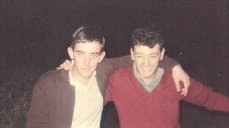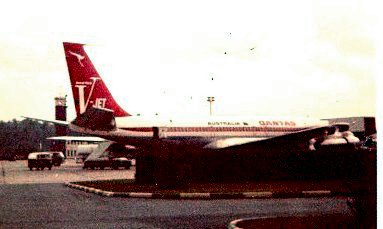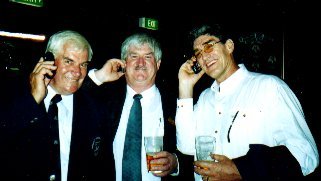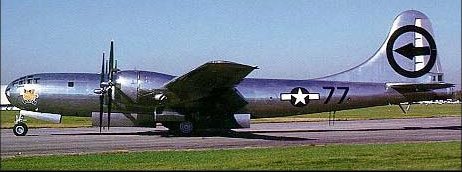|
|
||
|
|
Radschool Newsletter |
Vol 12 Page 6 |
|
|
||
|
At a barby!
John Boyne (elec) and John Mathwin (rad) at a beer-b-q on the banks of the Richmond River in 1967 (neither bloke would ride the old draft horse). As was common in those days, bar-b-q’s were not spoilt by introducing food into the equation, after all, why waste valuable time lighting a fire and cooking the stuff….
We recently heard from John Boyne who still lives out in Panther country to the west of Sydney. He had been with DeHav’s since he left the RAAF back in the 70’s. Back then, DeHav’s were hiring a lot of Ex-RAAF blokes, and John and a few others went straight to Bankstown after their D. Recently, though, Qantas took over DeHav’s, and you guessed it, one by one the old blokes were put off. John got his second D early in July of this year, and is now out there with his mates along with all the ex-Ansett blokes who are also looking for work, through no fault of their own. And there aren’t a lot of jobs in the Aviation game….
It seems that it didn’t matter one bit to Qantas that John and others had given 31 years of valuable service, they just didn’t fit the mould any more. We wish him, and a bunch of other blokes who we know are in the same predicament, all the best.
|
||
|
In Sydney at a crowded bus stop a beautiful young woman was waiting for the bus. Dressed up for work, she was wearing a very tight and short mini skirt. As the bus rolled up and it became her turn to get on the bus she became aware that her skirt was too tight to allow her leg to come up to the height of the bus' first step. Slightly embarrassed and with a quick smile to the bus driver she reached behind herself and unzipped her skirt a little thinking that this would give her enough slack to raise her leg. Again she tried to make the step onto the bus to discover she still could not make the step. So, a little more embarrassed she once again reached behind herself and unzipped her skirt a little more. For a second time she attempted the step and once again, and, much to her disgust she could not raise her leg because of the tight skirt.
With a coy little smile to the driver she again unzipped the offending skirt to give a little more slack and again was unable to make the step. About this time the big Queensland cane cutter, who was behind her in the line, picked her up easily around the waist and placed her lightly on the step of the bus. Well, she went ballistic and turned on the would-be hero, screeching at him ''How dare you touch my body!! I don't even know who you are!! ' At this the Queenslander drawled, ''Well ma'am, normally I would agree with you but after you unzipped my fly three times, I kinda figured we were friends.''
|
||
|
Qantas
We heard from Wayne Lawrence who was a flight steward with Qantas back in the late sixties, early seventies, and he and his mates were crew on the B707 charters that took all the blokes and blokettes to Viet Nam. They have established a web site at http://groups.msn.com/QANTASCabinCrewRetired/vietnamgroup.msnw (have a look) and are looking for any photos of the aircraft or blokes/blokettes getting on or off those aircraft while en-route. If you have any photos that you would like to share, please email them to us and we’ll show them here and forward them on to Wayne and his crew.
|
||
|
|
||
|
Qantas V-Jet at Singapore airport early on the 2 Sept, 1969. This is where everyone changed shirts and got off for breakfast. |
||
|
|
||
|
|
||
|
Who said that SP bookies were extinct…….here John Broughton (rad), Trevor Benneworth (rad) and Bob Meyer (inst) are seen at the recent Brisbane Anzac Day march aftermath, with pints in hand, but are they placing or taking…….. |
||
|
|
||
|
The B-29.
Boeing submitted the prototype for the B-29 long-range heavy bomber to the US Army in 1939 as an eventual replacement for the B17 and the B24. It made its maiden flight on September 21, 1942, but in December 1943 the Army decided not to use the aircraft in the European Theatre. This allowed it to be sent to the Pacific area where its great range made it particularly suited for the long over-water flights required to attack the Japanese homeland from bases in China. In April 1944, the first operational B-29s were introduced to the newly formed 20th Air Force which operated from dusty airfields in India.
During the last two months of 1944, B-29s began operating against Japan from the islands of Saipan, Guam and Tinian, and on one raid as many as 1,000 B-29's at one time bombed Tokyo, destroying large parts of the city. (Can you imagine the logistics of getting 1,000 serviceable aircraft into the air, and imagine the sight and noise of it all). On Aug. 6, 1945, the B-29 Enola Gay, under the command of Colonel Paul W. Tibbets, dropped the world's first atomic bomb on Hiroshima and three days later a second B-29, Bockscar, under the command of Major Charles W. Sweeney dropped another atomic bomb on Nagasaki. Shortly thereafter, Japan surrendered.
With the advent of the conflict in Korea in June 1950, the B-29 was once again thrust into battle and for the next several years it was effectively used for attacking targets in North Korea.
It was the most sophisticated, propeller-driven, bomber to fly during World War II, and the first bomber to house its crew in pressurized compartments and it contained very advanced propulsion, avionics and armament systems, including guns that could be fired by remote control. To protect the Superfortress, Boeing designed the most sophisticated defensive weapons system yet fitted to a military airplane. Engineers placed a total of five .50 calibre machine gun turrets on the fuselage, as well as a 20-mm cannon fitted in the tail beneath the rudder. Gunners operated these turrets by remote control, using computerized sights, and each gunner could take control of two or more turrets to concentrate firepower on a single target, making the system flexible and effective.
The front and rear crew areas were pressurized and connected by a long tube over the bomb bays. The tail gunner had a separate pressurized area that could only be left during unpressurized flight. For the first time, flying at extreme altitudes was almost comfortable. The B-29 was also the heaviest production plane ever built because of increases in range, bomb load and defensive requirements.
Boeing also equipped the B-29 with advanced radar equipment and avionics and it carried either the AN/APQ-13 or AN/APQ-7 Eagle radar system to aid bombing and navigation. These systems were accurate enough to permit blind bombing through cloud layers that completely obscured the target. It was also equipped with the AN/APG-15B airborne radar gun sighting system mounted in the tail, insuring accurate defence against enemy night fighters. However, the high-altitude, precision, bombing tactics yielded poor results so in March 1945, Major General Curtis E. LeMay ordered the group to abandon these tactics and strike instead at night, from low altitude, using incendiary bombs. These attacks, carried out by hundreds of B-29s, soon devastated much of Japan's industrial and economic infrastructure and contributed in no small way to the Japanese surrender.
Late in 1944, the US Army ordered a batch of Superfortress atomic bombers codenamed "Silverplate" aircraft. These aircraft were modified by removing all gun turrets except for the tail position, removing armour plate, installing Curtiss electric propellers, and configuring the bomb bay to accommodate either the "Fat Man" or "Little Boy" versions of the atomic bomb. The Army assigned 15 Silverplate aircraft to the 509th Composite Group commanded by Colonel Tibbets and he named his personal B-29 "Enola Gay" after his mother. This aircraft was restored in December 1984 and now rests in the Smithsonian Institution in Suitland, Maryland, and there are plans to move it to the Dulles International Airport in December 2003. In all, a total of 3,970 B-29s were built. Production ended in 1946.
After Korea, B-29s were adapted for several functions, including in-flight refuelling, anti-submarine patrol, weather reconnaissance, and rescue duty. The last B-29 in squadron use retired from service in September 1960.
For the tech heads,
Specifications: Wing Span: 141 ft. 3 in., Length: 99 ft. 0 in. , Height: 27 ft. 9 in., Weight: 133,500 lbs. MTOW. Engines: Four Wright R-3350 of 2,200 hp. ea.
Performance: Maximum speed: 357 mph Cruising speed: 220 mph. Range: 3,700 miles Service Ceiling: 33,600 ft.
|
||
|
You know that "special look" women get when they want sex? Me neither!! |
||
|
|
||
|
|
||
|
|
||
|
|
||



